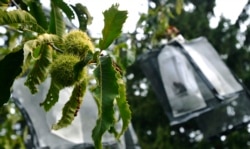American scientists are harvesting chestnuts like no other found in nature. These researchers work at New York State’s College of Environmental Science and Forestry in Syracuse, New York. About half the nuts they collect have a gene that provides resistance to a condition known as blight. The disease killed nearly all American chestnut trees during the 20th century.
The researchers will soon ask United States officials for permission to give out thousands of genetically engineered chestnut trees. Their hope is to return the American chestnut to many communities across the country.
The plan could expand the world of genetically engineered plants from farmland into forests. It also raises the question that scientists and others have been asking: Should genetic engineering be used in the wild to help save trees?
Some people are afraid of starting what they call an “irreversible experiment” in a highly complex ecosystem. Others see a technology already used in food production, one that could help save forests under attack from invasive organisms and diseases.
“We have this technology, it’s a very powerful technology, and we can use that now to save a species,” said William Powell, a molecular plant biologist. Powell directs the American Chestnut Research and Restoration Project at the college.
The researchers will ask the U.S. Department of Agriculture (USDA) to consider approving an American chestnut tree with a gene from wheat. The gene helps the tree resist cryphonectria parasitica, a fungus accidentally brought to the United States over 100 years ago.
The blight destroyed a tree species once found in forests from Maine to Georgia. Nuts from up to 4 billion trees were fed to farm animals, and its wood was used to build homes for American settlers. Then came the blight.
Creating a blight-resistant tree
Efforts to create American chestnut trees with an ability to fight the blight, like Chinese chestnut trees, are very complex. The genetically engineered method is easier, scientists say.
Powell and his research partner Charles Maynard began working many years ago at the request of the New York office of the American Chestnut Foundation. The added wheat gene enables the trees to make an enzyme that breaks down the fungus.
About half the chestnuts will have the gene, researchers say.
The researchers will ask the USDA’s Animal and Plant Health Inspection Service to examine the risks of the new tree. They want the agency to change its rules.
The USDA commonly approves genetically engineered crops. Most corn and soybean fields in the United States are used to grow crops engineered in some way.
But engineered trees have not been planted in the forests for environmental reasons. That could change as genetic changes become more common and trees are increasingly threatened by climate change and blight.
“If the chestnut is approved ... I think it’s accurate to say that it does help pave the way for other biotech trees,” said Jason Delborne. He is an associate professor of science, policy and society at North Carolina State University.
Long-term effects
Some scientists are concerned about the long-term effects of adding planting trees that can live for more than 200 years.
Forest eco-systems are complex and the current system of rule-making is not up to the job of studying the environmental and societal risks, said biotechnology expert Doug Gurian-Sherman.
“I think we have to step back and ask whether our ability to manipulate things is getting ahead of our ability to understand their impacts,” he said. Gurian-Sherman is a former senior scientist with the Union of Concerned Scientists.
Yet trees are dying from newly identified diseases and some scientists say biotech could help where other efforts have failed.
“Compared to what’s happening in the world…I think the risks of making a mistake due to (changing) a gene wrong are so small compared to the risks of doing nothing,” said Steven Strauss. He is a forest biotechnologist at Oregon State University in Corvallis.
I'm Susan Shand.
The Associated Press reported this story. Susan Shand adapted it for VOA Learning English. George Grow was the editor.
________________________________________________________________
Words in This Story
irreversible - adj. unchangeable
invasive – adj. spreads quickly and kills other plans
fungus – n. a living organism that spreads and lives on dead things
species – n. a group of individuals having the same physical and genetic qualities
manipulate – v. to change on purpose










